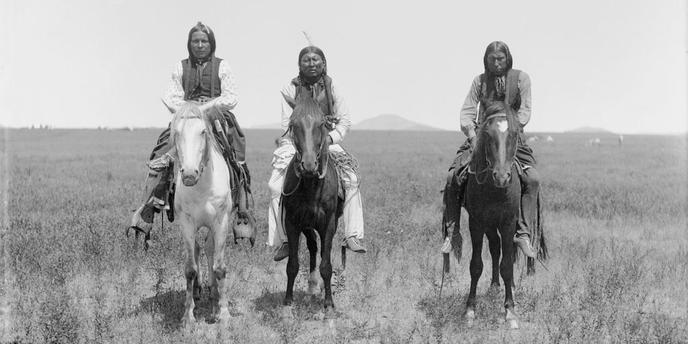Such beatific urges toward peace, combined with relentless and brutal raiding by Comanches in Texas and the Indian Territory led to the last and most comprehensive treaty ever signed by the Indians of the southern plains. The conference that spawned it took place in October 1867 at a campground where the Kiowas held medicine dances, about seventy-five miles southwest of the present site of Wichita, Kansas. The place was known as Medicine Lodge Creek. The participants were members of a U.S. peace commission and representatives of the Comanche, Cheyenne, Arapaho, Kiowa, and Kiowa Apache tribes. The conference was the last great gathering of free Indians in the American West. The event was magnificent, surreal, doomed, absurd, and bizarre, and surely one of the greatest displays of pure western pageantry ever seen. Nine newspapers sent correspondents to cover it. The council began, as many treaty meetings did, with each side making a great effort to impress the other. The U.S. peace commission, which included the commissioner of Indian affairs and William Tecumseh Sherman, the head of the army in the West, arrived with an entourage so large that it required a wagon train and fifteen or twenty ambulances to transport them. They were accompanied by a splendidly mounted guard of five hundred soldiers in dress uniform, dragging their lethal, snub-nosed mountain howitzers behind them. The white men had brought with them a large quantity of gifts, too, and set up huge mobile kitchens to feed everyone. Soon after they arrived they sent a rush order for additional supplies of fifteen thousand pounds of sugar, six thousand pounds of coffee, ten thousand pounds of hard bread, and three thousand pounds of tobacco. There were an estimated four thousand Indians in attendance, which included one hundred Comanche lodges.
Once the soldiers had drawn up before the Indian camp, something extraordinary happened. It was described by Alfred A. Taylor, later the governor of Tennessee, who covered the council as a reporter, as follows:
By this time, thousands of mounted warriors could be seen concentrating and forming themselves into a wedge-shaped mass, the edge of the wedge pointing toward us. In this sort of mass formation, with all their war paraphernalia, their horses striped with war paint, the riders bedecked with war bonnets and their faces painted red, came charging in full speed toward our columns. . . .
When within a mile of the head of our procession, the wedge, without hitch or break, quickly threw itself into the shape of a huge ring or wheel without hub or spokes, whose rim consisted of five distinct lines of these wild, untutored, yet inimitable horsemen. This ring, winding around and around with the regularity and precision of fresh-oiled machinery, approached nearer and nearer to us with every revolution. Reaching within a hundred yards of us at breakneck speed, the giant wheel or ring ceased to turn and suddenly came to a standstill.This maneuver was enormously impressive to the white people, not least because it amounted to a test of faith. The giant, spinning wheels-within-wheels formation was a trademark of plains warfare, and the sight of it whirling ever closer would have been eerily familiar to the soldiers who sat their horses in that long parade line. There was also a hint of sadness in all of this martial pomp and circumstance, and many who were there sensed it. The very purpose of the council was to end once and for all this sort of behavior, or to render it meaningless and ceremonial. Such an exhibition, indeed, would be witnessed only a few more times before it passed forever into myth and history and phonied-up traveling shows like Buffalo Bill's.
S.C. Gwynne, from Empire of the Summer Moon: Quanah Parker and the Rise and Fall of the Comanches, the Most Powerful Indian Tribe in American History








































































































































































No comments:
Post a Comment